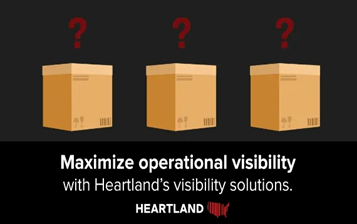
How to Increase Real-Time Visibility in Your Freight Operations
Feb 01, 2024
The logistics industry is constantly evolving. From direct-to-customer shipping to new versatile truck-loading options, logistic teams navigate a myriad of challenges to achieve one goal: deliver accurate orders on time. As transportation companies seek to improve operations, one cannot overlook freight visibility. As a critical part of the supply chain, freight deals with the movement of goods from one place to another. However, in light of today’s dynamic supply chains, businesses must track multiple data points when managing freight operations. Traditional tracking methods once leveraging paper-and-pen systems are no longer suitable in today’s fast-paced landscape. Signs of ineffective visibility often include:
- Inventory inconsistencies – As expected, reduced visibility into stock location and inventory levels contributes to stockouts, delayed replenishment, and poor customer service.
- Disorganized resource allocation – Blind spots within freight operations may conceal pressing needs within your workflows, leading to the improper utilization of warehouse space and technologies.
- Poor decision-making – Delayed information impacts response times, hindering proactive decision-making as teams must react quickly to upcoming challenges.
To resolve these challenges and ensure accurate, on-time delivery, ample attention should be given to your operational visibility systems.
- Start with Collaboration
Before making any major decisions, it is highly recommended that you first evaluate potential partners to assist your IT team in procuring, deploying, and maintaining your solution. Additional partners may include suppliers, carriers, and customers. Dedicated collaboration ultimately helps to identify potential issues in the delivery process and improve communication between all parties involved.
- Select Scalable Real-Time Visibility Technology
Automation is foundational to simplify tracking. Of the many systems currently in the market, RFID tracking has shown great promise in improving accuracy and throughput rates simultaneously. Unlike traditional barcoding, RFID tracking provides instant updates on inventory status and movement. For example, incoming inventory is tagged with an RFID label upon arrival. RFID tags are then read by RFID readers as products move throughout your facility. The information collected by readers can be used to track location and stock levels.
- Prioritize Standardization
Essential to securing real-time visibility, standardization ensures that all parties involved in the delivery process are using the same systems and processes. This helps to eliminate confusion and improves the accuracy of information. Achieving standardization is simpler via a digital reporting system, such as a TMS or IMS, and automated data capture. Handheld scanners can capture data and automatically save them in predefined reports to be shared across your facility with key stakeholders.
- Empower Data Analytics
Increasing inventory control, data analysis empowers teams to identify trends and patterns in the delivery process. Captured information can be used to improve the delivery process and increase real-time visibility. Proactive risk management and accurate demand forecasting are only a few of the benefits stemming from dependable data analytics. Whether gathered via a handheld or hands-free terminal, data analytics provide greater control of goods and shipments to identify potential issues in the delivery process.
- Make Room for Continuous Improvement
Improving visibility is a continuing process. Therefore, consider planning for ongoing evaluations, assisted support, and system updates to preserve scalability. This helps to ensure that the delivery process is always optimized and that real-time visibility is maintained. A comprehensive solution partner should work alongside your team to ensure these needs are met.
Getting Started with RFID Tracking
Going a step further than 1D/2D barcoding, RFID scanning increases inventory visibility to 99.99%, equipping freight operations with:
- Improved inventory accuracy: Real-time tracking is a highly effective way to reduce discrepancies and prevent shrinkage.
- Enhanced operational efficiency: Accelerate packing, loading, and shipping with a data capture solution that doesn’t require line-of-sight and scans multiple codes at once.
- Reduced labor costs: Replace overbearing, manual tasks with automatic data capture to verify shipments quickly at the loading dock.
- Better customer service: Improve customer service by enabling real-time order tracking and maximizing accuracy rates.
- Data-driven decision-making: Proactively manage inventory levels and resource allocation with real-time insights.
Real-time visibility is limitless. In addition to tagging incoming inventory, RFID tracking also empowers forklifts to locate and move pallets, expediting freight operations. Order pickers can pair their handheld computers with RFID sleds to update inventory management systems remotely as they retrieve items from shelves ensuring accuracy and speed. Nevertheless, whether deploying RFID or an alternative form of inventory tracking, the power of real-time visibility must extend beyond the four walls.
RFID isn’t the only technology transforming inventory tracking. Explore your options here.
Ensuring Freight Visibility
As inventory moves out of the distribution center, visibility solutions are crucial to ensuring product quality beyond the shipping dock. Leading distributor and logistic teams report using a mix of the solutions below:
- High-Resolution Cameras for Proof of Delivery – End-to-end traceability depends on verifiable proof of condition to ensure a positive customer experience. Advanced mobile devices may be equipped with high-resolution cameras to capture proof of delivery and update package movements in real time.
- Long-Range Connectivity to Communicate with Administrators – Effective communication is critical to maximizing freight visibility and safeguarding accurate shipping. That’s why long-range cellular and wireless networks are vital to unifying delivery teams with accurate shipping data, ETAs, and route changes. Partnering with an experienced connectivity specialist, businesses can tailor a network plan that embraces future-forward channels while remaining within their budget.
- IoT Sensors enabled by Bluetooth – IoT sensors offer real-time monitoring of warehouse operations, providing detailed insights into inventory levels, stock movements, temperature, humidity, and other critical data. Next-generation IoT sensors can leverage Bluetooth connectivity to capture and relay data instantaneously with minimal signal interference.
Real-time visibility in freight operations is essential to ensure the safe and timely delivery of goods. Tracking technology, dedicated collaboration, standardization, and reliable data collection can all help increase operational visibility in freight operations. Contact our team to implement these strategies and start improving the delivery process for maximized customer satisfaction.




